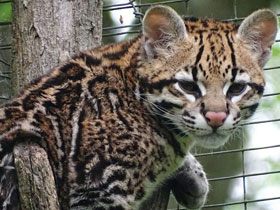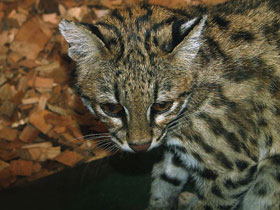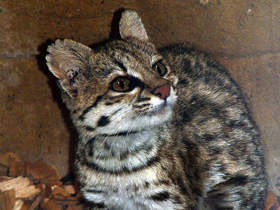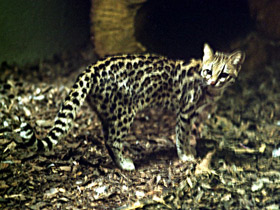The oncilla, the northern tiger cat, little spotted cat, and tigrillo (Leopardus tigrinus)
The oncilla (Leopardus tigrinus), also known as the northern tiger cat, little spotted cat, and tigrillo, is a small spotted cat ranging from Central America to central Brazil. It is listed as Vulnerable on the IUCN Red List, and the population is threatened by deforestation and conversion of habitat to agricultural land.
In 2013, it was proposed to assign the oncilla populations in southern Brazil, Paraguay, and Argentina to a new species: the southern tiger cat (Leopardus guttulus), after it was found that it does not interbreed with the oncilla population in northeastern Brazil.
Appearance
Leopardus tigrinus is a species of carnivorous mammal in the family Felidae. The name of this wild cat translates as "little jaguar", as its build and colouration resemble those of a miniature jaguar. However, Leopardus tigrinus is the smallest of the neotropical felids. Leopardus tigrinus is slightly larger than a domestic cat; an adult male can weigh between 2.8 and 3 kg with a body length of up to 65 cm. The tail of Leopardus tigrinus is shorter (30-40 cm) and the eyes and ears are comparatively larger than those of other members of the genus Leopardus.
The coat of Leopardus tigrinus is smooth and short. The colouring of the coat is ochre, with a whitish belly and thorax and light-coloured markings on the muzzle. The pattern on the back and sides consists of irregular, ring-shaped dark patches, arranged in longitudinal rows. The patches are continuous, not scattered in separate spots. The tail is covered with transverse dark spots, which merge into rings near the end of the tail. The ears are rounded, black on the outside, with a white spot in the centre. Melanistic cats are common; their number reaches 1/5 of the whole population.
Habitat
It is a nocturnal feline native to the tropical forests of Central and South America between 600 and 4300 m asl.
The oncilla is present from Costa Rica and northern Panama to southeastern Brazil and northern Argentina. The range of Leopardus tigrinus is restricted to montane and subtropical forests, is very mosaic and in most places is rare. Leopardus tigrinus is widespread but quite rare. In the 1970s and 1980s, they were hunted and collected by the tens of thousands for their beautiful fur. In 1983 alone, 84,000 Leopardus tigrinus skins were confiscated from poachers. The current population of Leopardus tigrinus is estimated at about 50,000 adults, but this number is gradually declining due to deforestation for coffee plantations and poaching. Leopardus tigrinus is listed as vulnerable on the IUCN Red List.
Leopardus tigrinus inhabits subtropical forests, preferring moist evergreen forests and montane rainforests up to 3000 m altitude. It has also been found in dry forests in Venezuela, in abandoned eucalyptus plantations and in logged forest areas, including in the vicinity of human settlements. It has 3 or 4 subspecies, differing in basic colouring, coat length and intensity of pattern.
Life history and reproduction
Leopardus tigrinus is an almost unstudied species. It is apparently a solitary species, active mainly at night and resting on tree branches during the day, where its variegated patterning makes it almost invisible. It feeds on small rodents, birds, possibly non-venomous snakes and tree frogs. Leopardus tigrinus is reported to prey on small primates in Brazil.
Nothing is known about Leopardus tigrinus breeding in the wild; all data are from captive observations. Pregnancy lasts 74-78 days in females. The litter consists of 1-2 kittens, whose eyes open in the third week. At the age of 1-2 years, the young cheetahs reach sexual maturity. The lifespan in captivity is up to 20 years; in the wild 12 to 15 years.
Taxonomy
The following are the traditionally recognized subspecies:
- Leopardus tigrinus tigrinus, eastern Venezuela, Guyana, northeastern Brazil; the nominate subspecies.
- Leopardus tigrinus guttulus, Atlantic forest central and southern Brazil, Uruguay, Paraguay, northern Argentina (later recognised as a separate species, the southern tigrina).
- Leopardus tigrinus oncilla, Central America.
- Leopardus tigrinus pardinoides, western Venezuela, Colombia, Ecuador, Peru.
Although the Central American oncilla is listed as a separate subspecies, based on analysis of mitochondrial DNA, Johnson et al. (1999) found strongly supported differences between Leopardus tigrinus oncilla in Costa Rica and Leopardus tigrinus guttulus in southern Brazil, comparable to differences between different neotropical species. Researchers have argued that there should be a splitting of the oncilla into two species, as there is a pronounced difference in appearance between the oncillas in Costa Rica and those in central and southern Brazil. Further samples of Leopardus tigrinus oncilla are needed from northern South America to determine whether this taxon ranges outside Central America, and whether it should be considered a distinct species rather than a subspecies.
In 2013, genetic research revealed that the former subspecies Leopardus tigrinus guttulus is a separate cryptic species that does not interbreed with the other subspecies, and proposes a classification into two species Leopardus guttulus and Leopardus tigrinus.
A zone of hybridization between the oncilla and the colocolo (Pampas cat) has been found through genetic analyses of specimens from central Brazil.
Results of a morphological analysis of 250 samples of skins and skulls indicate that there are three distinct oncilla groups: namely one in South America's northern, north-western and western range countries, one in eastern and one in southern range countries. Based on these results, the eastern group was proposed to be a distinct species Leopardus emiliae. A further phylogenetic study published in 2021 supported the recognition of a third species.
Threats
The oncilla is mainly threatened by deforestation and poaching. Oncillas are killed for their pelts, which are highly prized and often sold or made into clothing. Reports in 1972 and 1982 in South America showed that the oncilla is one of the four most heavily hunted of all the small wild cats.
Another factor contributing to oncilla mortality is human expansion and conversion of land for settlements. Coffee plantations are most often established in cloud forest habitats, causing the reduction of preferred habitats.
Hybridization of the oncilla with the Geoffroy's cat (Leopardus geoffroyi) has been found in the southernmost part of its range; hybridization with the Pampas cat (L. colocola) has also been found in central Brazil. Such hybridization may be a natural process, and the extent of this as a threat to the oncilla is unknown.
Conservation
The oncilla has been classified as Vulnerable on the IUCN Red List. It is listed on CITES Appendix I, prohibiting all international commercial trade in oncillas or products made from them. Hunting is still allowed in Ecuador, Guyana, Nicaragua and Peru.




















































